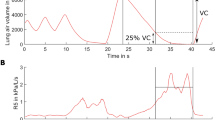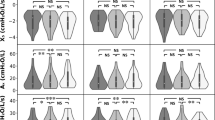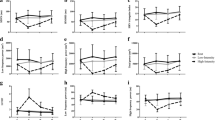Abstract
Determining the possible adverse health effects of air pollutants can be complicated by differences in the environmental conditions of temperature and humidity. To evaluate the potentially confounding effects of differences in temperature and humidity, we exposed 8 normal male subjects and 8 male subjects with asthma to the extremes in temperature and humidity that could be maintained in an environmental chamber. We performed serial pulmonary function tests for these subjects before and during 6 hr exposure periods on 5 separate occasions: cold, dry (10°C, 10% relative humidity); cold, humid (10°C, 50% relative humidity); normal ambient (22°C, 40% relative humidity); hot, dry (37°C, 15% relative humidity); and hot, humid (37°C, 60% relative humidity). The exposure period included a 12 min exercise on a cycle ergometer. We found no significant change in spirometry, airways resistance, or diffusing capacity for either group of subjects at rest alone over the 6 hr period of exposure for any exposure condition. However, there were changes in spirometry and airways resistance as a result of the 12 min period of exercise. The subjects with asthma had significant decreases in forced expiratory volume in 1 sec (FEV1) (20–21%) and increases in specific airways resistance when exercising in conditions of cold and dry, cold and humid, and hot and dry. The normal subjects had an average increase in FEV1 of approximately 6% when exercising in the hot and humid conditions. We found significant correlations for the changes in FEV1 with the water content of the exposure conditions for both groups of subjects. We also found that the work performance (expressed as the external work performed divided by the oxygen consumed) was decreased for the subjects in both groups at the conditions of the higher temperature (37°C) compared with the lower temperature (10°C). These results confirm that controlling for the conditions of temperature and humidity is essential in chamber studies, field studies, or epidemiologic evaluations determining the adverse effect of an air pollutant.
Similar content being viewed by others
References
Chen WY, Horton DJ (1977) Heat and water loss from the airways and exercise-induced asthma. Respiration 34:305–313
Deal EC Jr, McFadden ER Jr, Ingram RH Jr, Strauss RH, Jaeger JJ (1979) Role of respiratory heat exchange in production of exercise-induced asthma. J Appl Physiol 46:467–475
Eschenbacher WL, Sheppard D (1985) Respiratory heat loss is not the sole stimulus for bronchoconstriction induced by isocapnic hyperpnea with dry air. Am Rev Respir Dis 131:894–901
Fink WJ, Costiil DL, VanHandel PJ (1975) Leg muscle metabolism during exercise in the heat and cold. Europ J Appl Physiol Occup Physiol 34:183–190
Friedlander SK, Altshuler B, Bayes KD, Eschenroeder AQ, Hackney JD, Heck WW, McCarroll JR, McNesby JR, Miller PR, Mueller PK, Murphy SD (1977) Ozone and other photochemical oxidants. National Academy of Sciences, Washington, DC
Gelb AF, Tashkin DP, Epstein JD, Gong H, Zamel N (1985) Exercise-induced bronchodilation in asthma. Chest 87:196–201
Haas F, Pasierski S, Levine N, Bishop M, Axen K, Pineda H, Haas A (1987) Effect of aerobic training on forced expiratory airflow in exercising asthmatic humans. J Appl Physiol 63:1230–1235
Hahn A, Anderson SA, Morton AR, Black JL, Fitch KD (1984) A reinterpretation of the effect of temperature and water content of the inspired air in exercise-induced asthma. Am Rev Respir Dis 130:575–579
Higgins ITT, D'Arcy JB, Gibbons DI, Avol EL, Gross KB (1990) Effect of exposures to ambient ozone and ventilatory lung function in children. Am Rev Respir Dis 141:1136–1146
Kreit JW, Gross KB, Moore TB, Lorenzen TJ, D'Arcy J, Eschenbacher WL (1989) Ozone-induced changes in pulmonary function and bronchial responsiveness in asthmatics. J Appl Physiol 66:217–222
MacDougall JD, Reddan WG, Layton CR, Dempsey JA (1974) Effects of metabolic hyperthermia on performance during heavy prolonged exercise. J Appl Physiol 36:538–544
Nadel ER, Cafarelli E, Roberts MF, Wenger CB (1979) Circulatory regulation during exercise in different ambient temperatures. J Appl Physiol 46:430–437
Spektor DM, Lippmann M, Lioy PJ, Thurston K, Citak DJ, Bock N, Speizer FE, Hayes C (1988) Effects of ambient ozone on respiratory function in active normal children. Am Rev Respir Dis 137:313–320
Author information
Authors and Affiliations
Additional information
Offprint requests to: W. L. Eschenbacher
Rights and permissions
About this article
Cite this article
Eschenbacher, W.L., Moore, T.B., Lorenzen, T.J. et al. Pulmonary responses of asthmatic and normal subjects to different temperature and humidity conditions in an environmental chamber. Lung 170, 51–62 (1992). https://doi.org/10.1007/BF00164755
Accepted:
Issue Date:
DOI: https://doi.org/10.1007/BF00164755




